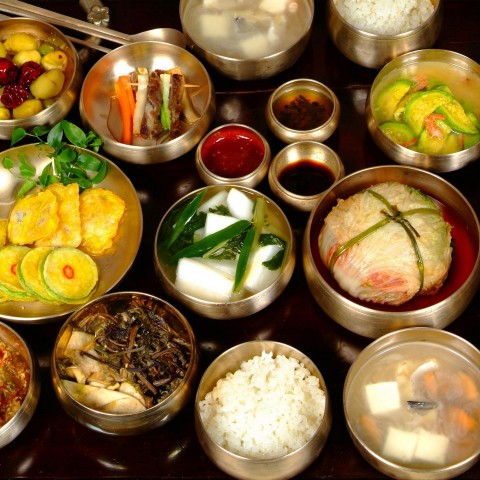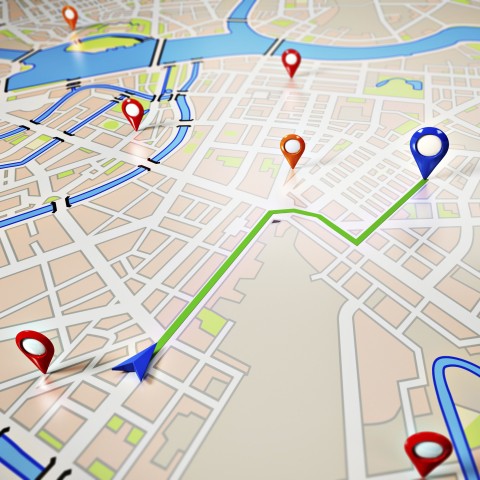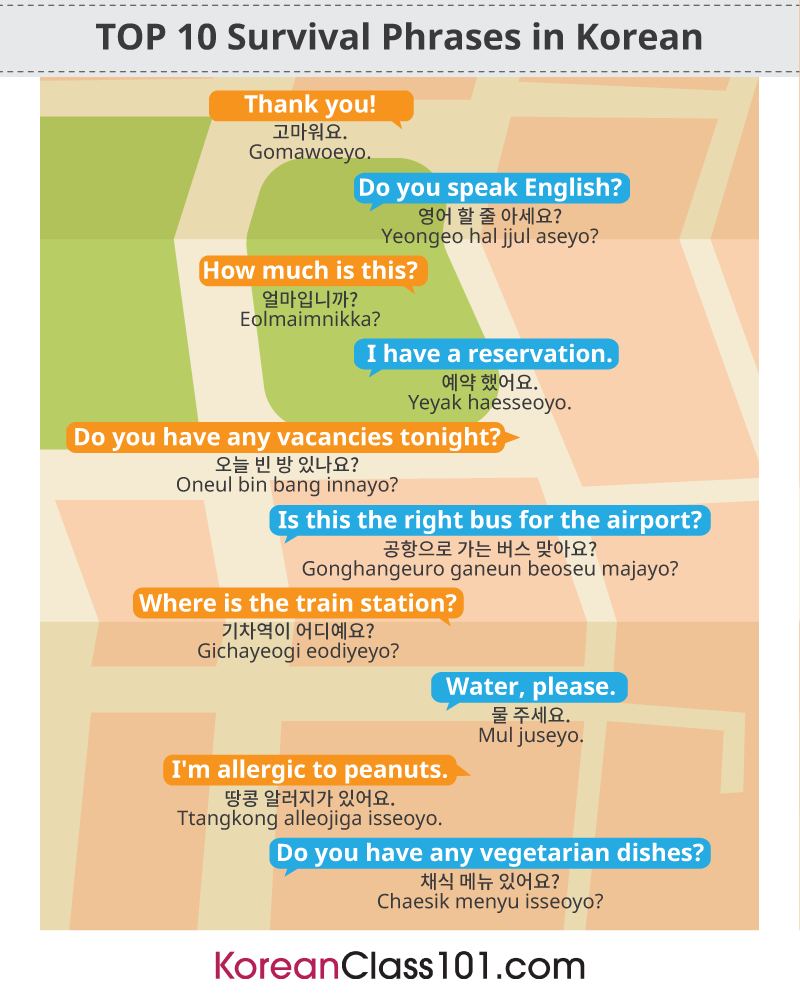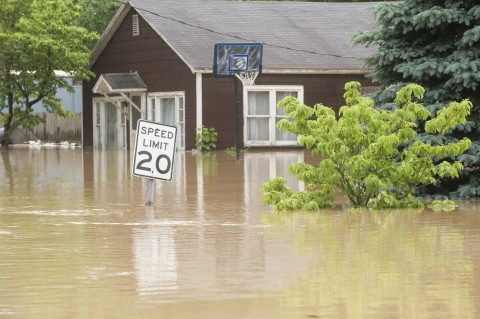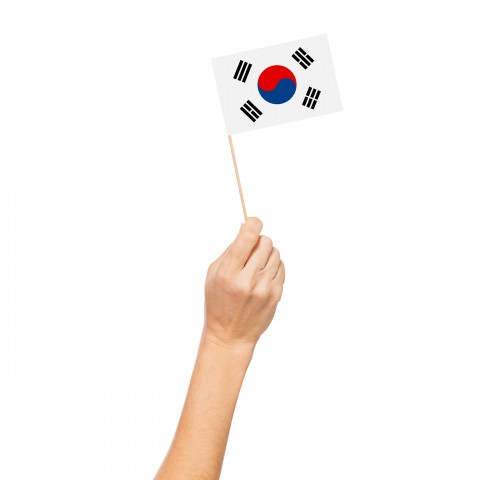Are you planning to travel to Korea? Korean travel phrases in language-learning are absolutely essential for just this reason!
Learning basic South Korean travel phrases will definitely help you in nearly any situation, including urgent ones. The Korean travel phrases and Korean travel words you’ll learn in this article will make your travels more fun and help you connect with locals, so that you can get the most out of your upcoming trip to South Korea!
Table of Contents
- Essential Korean Travel Phrases: Basic Expressions
- Essential Korean Phrases: Transportation
- Essential Korean Phrases: Shopping
- Essential Korean Phrases: At Restaurants
- Essential Korean Phrases: Asking for and Giving Directions
- Essential Korean Phrases: Emergencies
- Essential Korean Phrases: Flattery Phrases
- Essential Korean Phrases: Useful Phrases to Go Through Language Problems
- Essential Korean Phrases: Buying Tickets at a Museum
- Essential Korean Phrases: Taking Pictures
- How KoreanClass101.com Can Help You with Korean
1. Essential Korean Travel Phrases: Basic Expressions
You’ll be able to converse with local native Koreans by simply remembering these basic phrases. Koreans will appreciate the fact that you made the effort to speak to them in their local language, and it will certainly add more fun to your South Korea trip.
1- 안녕하세요 (annyeonghaseyo) – “hello” (polite form)
This is one of the most basic and commonly used Korean phrases for travelling, so be sure to keep it in your arsenal!
Example 1:
You enter a restaurant and a waitress greets you.
- Waitress: 안녕하세요.
Waitress: Annyeonghaseyo.
Waitress: “Hello.” - You: 안녕하세요.
You: Annyeonghaseyo.
You: “Hello.”
Example 2:
You take a taxi and want to greet the taxi driver.
- You: 안녕하세요.
You: Annyeonghaseyo.
You: “Hello.” - Taxi driver: 네, 안녕하세요. 어디로 가시나요?
Taxi driver: Ne, annyeonghaseyo. Eodiro gasinayo?
Taxi driver: “Yes, hello. Where would you like to go?”
2 – 반갑습니다 (bangapseumnida) – “nice to meet you” (polite form)
Example 1:
Jason went to your friend’s house and met their roommate, who is older than him, for the first time.
- Roommate: 어? 친구 데려왔어? 누구야?
Roommate: Eo? Chingu deryeowasseo? Nuguya?
Roommate: “Oh, you brought your friend home? Who is he?” - Jason: 안녕하세요, 반갑습니다.
Jason: Annyeonghaseyo, bangapseumnida.
Jason: “Hello, nice to meet you.”
Example 2:
Michael went to a language exchange event in Hongdae and wants to introduce himself to others.
- Michael: 안녕하세요, 저는 마이클이라고 합니다. 반갑습니다.
Michael: Annyeonghaseyo, jeoneun maikeurirago hamnida. Bangapseumnida.
Michael: “Hello, my name is Michael. Nice to meet you.”
3 – 감사합니다 (gamsahamnida) – “thank you” (polite form)
Example 1:
You’re walking in the busy streets in the Gangnam area, and see a lady drop her wallet. You pick it up and give it to her.
- You: 여기, 지갑 떨어뜨리셨어요.
You: Yeogi, jigap tteoreotteurisyeosseoyo.
You: “Here, you dropped your wallet.” - Lady: 어머, 감사합니다.
Lady: Eomeo, gamsahamnida.
Lady: “Oh, thank you so much.”
Example 2:
You order a cup of coffee at The Coffee Bean & Tea Leaf and a clerk gives you the change after you’ve paid.
- Clerk: 500원 거스름돈 드리겠습니다.
Clerk: Obaegwon geoseureumdon deurigetseumnida.
Clerk: “Here is [your] change, 500 won.” - You: 감사합니다.
You: Gamsahamnida.
You: “Thank you.”
4 – 실례합니다 (sillyehamnida) – “excuse me” (polite form)
This is one of the most useful Korean travel phrases you can learn, so keep it in mind.
Example 1:
You’re on a crowded subway and need to get closer to the exit.
- You: 실례합니다. 지나가겠습니다.
You: Sillyehamnida. Jinagagetseumnida.
You: “Excuse me. Passing through.”
Example 2:
You accidentally stepped on a stranger’s foot inside the busy subway.
- You: 실례합니다.
You: Sillyehamnida.
You: “Excuse me.”
5- 네; 아니요; 괜찮아요. (ne; aniyo; gwaenchanayo.) – “yes; no; no, thank you.”
While you learn Korean travel phrases, never underestimate the importance of even the smallest words. They can have the most impact!
Example 1:
- You: 이쪽으로 가면 화장실인가요?
You: Ijjogeuro gamyeon hwajangsiringayo?
You: “Is this way to the toilet?” - Clerk: 아니요, 그쪽은 창고예요.
Clerk: Aniyo, geujjogeun changgoyeyo.
Clerk: “No, that’s the storage section.” - You: 아, 그럼 저쪽으로 가면 되나요?
You: A, geureom jeojjogeuro gamyeon doenayo?
You: “Ah, so should I go that way?” - Clerk: 네, 맞아요.
Clerk: Ne, majayo.
Clerk: “Yes, correct.”
Example 2:
You had a great time hanging out with your friend. But it’s getting late—time to go home.
- Friend: 많이 어두워졌네, 집에 데려다 줄까?
Friend: Mani eoduwojyeonne, jibe deryeoda julkka?
Friend: “It became really dark. Did you want me to take you to your home?” - You: 아니, 괜찮아. 혼자갈 수 있어.
You: Ani, gwaenchana. Honjagal su isseo.
You: “No, I’m fine. I can go home by myself.”
We have more free lessons like “Top 10 Conversational Phrases,” so do check out this page when you have time.
2. Essential Korean Phrases: Transportation
Traveling by public transportation is the most efficient way to get around South Korea. The fares for the subway and public buses are very cheap, and the routes are easy to understand. There are also announcements offered in various languages, so the chance of getting lost is slim.
However, you need to remember that most of the staff at the ticket booths don’t speak English. Let’s learn the most important and useful phrases for buying tickets and conversing with any staff that you encounter.
1- ~으로 가는 티켓 주세요. (~euro ganeun tiket juseyo.)
~으로 가는 티켓 주세요. (~euro ganeun tiket juseyo.) means “Please give me a ticket to ~.” Use this phrase to buy any tickets to go out of the city area.
Example 1:
You’re at Dong-Daegu train station (동대구역; dongdaeguyeok) to buy a train ticket to Busan.
- You: 부산으로 가는 티켓 주세요.
You: Busaneuro ganeun tiket juseyo
You: “I would like to buy a ticket to go to Busan.” - Staff: 출발시간은 언제가 괜찮으십니까?
Staff: Chulbalsiganeun eonjega gwaenchaneusimnikka?
Staff: “When would you like to depart?” - You: 오후 1시쯤 출발하는 기차 있을까요?
You: Ohu 1sijjeum chulbalhaneun gicha isseulkkayo?
You: “Are there any trains that depart at 13:00 (one o’clock PM)?”
Example 2:
You’re at the Seoul Express Bus Terminal to buy a bus ticket to Pohang (포항; pohang).
- You: 안녕하세요, 오후 1시 포항으로 가는 티켓 주세요.
You: Annyeonghaseyo, ohu 1si pohangeuro ganeun tiket juseyo.
You: “Hello, I would like to buy a ticket to go to Pohang at 13:00 (one o’clock PM).” - Staff: 네, 몇장 드리면 될까요?
Staff: Ne, myeotjang deurimyeon doelkkayo?
Staff: “Okay, how many tickets do you need?” - You: 한장이요.
You: Hanjangiyo.
You: “Just one.”
2- ~으로 가는 전철/버스 인가요? (~euro ganeun jeoncheol/beoseu ingayo?)
This phrase means “Does this subway/bus go to ~?”
It’s likely that you’ll take a bus or subway to get around in South Korea. This travel phrase will come in handy when you want to ask a question to locals. When you travel by boat or ferry, simply replace the noun with “boat” (배; bae).
Example 1:
You’re at the Incheon airport and need to go to the Jamsil area. A bus stops in front of you, and you want to ask whether this bus goes to Jamsil.
- You: 잠실로 가는 버스인가요?
You: Jamsillo ganeun beoseuingayo?
You: “Does this bus go to Jamsil?” - Staff: 네, 갑니다.
Staff: Ne, gamnida.
Staff: “Yes, it does.”
Example 2:
You’re at Gukje market in Busan and you need to catch the subway to go to Gimhae International airport.
- You: 실례합니다. 이 전철은 부산 공항으로 가는 전철인가요?
You: Sillyehamnida. i jeoncheoreun busan gonghangeuro ganeun jeoncheoringayo?
You: “Excuse me. Does this subway go to the Busan airport?” - Stranger: 아니요, 부산 공항으로 가는 전철은 저쪽이예요.
Stranger: Aniyo, busan gonghangeuro ganeun jeoncheoreun jeojjogiyeyo.
Stranger: “No, the subway bound for the Busan airport is over there.” - You: 감사합니다.
You: Gamsahamnida.
You: “Thank you.”
3- ~으로 가주세요. (~euro gajuseyo.)
This phrase means “Please take me to ~.”
This travel phrase is the most effective and simple phrase to tell your taxi driver. Simply add the destination that you want to reach, such as “Insadong” (인사동; insadong) or “Dongdaemun” (동대문; dongdaemun) etc., followed by 으로 가주세요. (~euro gajuseyo.). That’s it. You don’t need to say anything else!
However, if you want to go somewhere less touristy, and it requires you to explain where exactly you want to go, give the taxi driver the address. Every taxi has a navigation system installed. Also, taxi companies provide free interpreter services in South Korea.
To know whether the taxi you got in offers this service, take a look on the right-hand side of the door. Usually, there’s a large rectangular sign that explains about this service in English, Japanese, and Chinese. So if you’re struggling to explain where you want to go, simply say “free interpreter” to the taxi driver.
Example 1:
You’re at “Gangnam station” (강남역; gangnamyeok) right now and want to move to “Itaewon” (이태원; itaewon) to have dinner with your friends.
- You: 안녕하세요, 이태원역으로 가주세요.
You: Annyeonghaseyo, itaewonyeogeuro gajuseyo.
You: “Hello, please take me to Itaewon station.” - Taxi driver: 네, 알겠습니다.
Taxi driver: Ne, algetseumnida.
Taxi driver: “Sure.”
Example 2:
You want to visit your friend’s house in Busan, and you have his address.
- You: 안녕하세요, 이곳으로 가고 싶은데요.. (주소를 보여줌)
You: Annyeonghaseyo, igoseuro gago sipeundeyo.. (jusoreul boyeojum)
You: “Hello, I would like to go to this place…” (show him the address) - Taxi driver: 잠시만요. (네비게이션으로 주소 확인함)
Taxi driver: Jamsimanyo. (nebigeisyeoneuro juso hwaginham)
Taxi driver: “Please hold on…” (checks the location via navigation system)
3. Essential Korean Phrases: Shopping
1 – 이거/저것 얼마예요? (igeo/jeogeot eolmayeyo?)
This phrase means “How much is this/that?”
Use this travel phrase when you want to ask the seller how much the items cost while shopping in South Korea. To get the seller’s attention, you can say 저기요 (jeogiyo) which means “excuse me.” If the seller is male, you can call him by 아저씨 (ajeossi) meaning “mature man,” and if the seller is female, you can call her by 아줌마 (ajumma) meaning “matured female” or 이모 (imo) meaning “aunt.”
Also, remember that 이것 (igeot) means “this” and 저것 (jeogeot) means “that.” If you want each of them to be plural, say 이것들 (igeotdeul) meaning “these” and 저것들 (jeogeotdeul) meaning “those.”
Example 1:
You’re shopping at a famous market called “Gwangjang market” (광장시장; Gwangjangsijang), in Seoul. You found a set of Korean traditional clothing called “Hanbok” (한복; hanbok) which you want to buy, and you’re curious to know how much it costs.
- You: 아저씨, 이거 얼마에요?
You: Ajeossi, igeo eolmaeyo?
You: “Excuse me sir, how much is this?” - Seller: 7만원이에요.
Seller: Chilmanwonieyo.
Seller: “It’s 70,000 won.”
Example 2:
You found a pink sweater that you like while shopping at 서문시장 (seomun sijang) in Daegu. You want to ask how much the sweater costs.
- You: 저기요, 저건 얼마예요?
You: jeogiyo, jeogeon eolmayeyo?
You: “Excuse me, how much is that?” - Seller: 2만9천원이예요.
Seller: Imangucheonwoniyeyo.
Seller: “It’s 29,000 won.” - You: (저거) 한개 주세요.
You: (jeogeo) Hangae juseyo.
You: “Please give me one (of that).”
2 – 이거 #개 주세요. (igeo #gae juseyo.)
This phrase means “Please give me [number] [of the product].”
Example 1:
You’re at the supermarket and the clerk wants to ask how many plastic bags you want.
- Seller: 비닐봉지 몇개 드릴까요?
Seller: Binilbongji myeotgae deurilkkayo?
Seller: “How many plastic bags would you like to have?” - You: 2개 주세요.
You: Dugae juseyo.
You: “Two please.”
Example 2:
You found a beautiful “Korean traditional pocket” called 전통 주머니 (jeontong jumeoni) and want to buy six of them.
- You: 이거 6개 주세요.
You: Igeo yeoseotgae juseyo.
You: “Please give me six (of the Korean traditional pockets).” - Seller: 네.
Seller: Ne.
Seller: “Ok.”
On our website, KoreanClass101, you can find many lessons on counting numbers in Korean. Feel free to check out our website whenever you want.
3- 조금만 깎아 주시면 안될까요? (Jogeumman kkakka jusimyeon andoelkkayo?)
This phrase means “Can you please reduce the price?”
The prices in Korea are usually fixed, but you can definitely negotiate the price at a market. To ask for a discount, use this phrase!
If you want to buy items for a cheaper price in Korea, try to pay by cash. If you pay with a credit card, you’ll be charged extra (approximately ten percent more).
Example 1:
You’re at 남대문시장 (Namdaemun sijang) meaning “Namdaemun market” in Seoul and found a nice jacket. You ask for the price and think that it costs too much. You want to negotiate the price.
- You: 너무 이쁘긴한데… 비싸네요. 조금만 깎아 주시면 안될까요?
You: Neomu ippeuginhande… bissaneyo. Jogeumman kkakka jusimyeon andoelkkayo?
You: “It’s really pretty…but it’s expensive. Can you please reduce the price a bit?” - Seller: 그럼 3,000원만 깎아 줄게요.
Seller: Geureom samcheonwonman kkakka julgeyo.
Seller: “I will give you a discount of 3,000 won then.”
Example 2:
You’re at 고속터미널 역 지하상가 (gosokteomineol yeok jihasangga) an underground shopping mall in the Express Bus Terminal station in Seoul, and want to buy a pair of jeans. The sign says that it costs 10,000 won if you pay by cash. But you only have a credit card.
- You: 이거 카드로 계산할게요.
You: Igeo kadeuro gyesanhalgeyo.
You: “I will pay by credit card.” - Seller: 카드로 계산하면 11,000원이에요. 현금으로 내는게 더 저렴해요.
Seller: kadeuro gyesanhamyeon mancheonwonieyo. hyeongeumeuro naeneun ge deo jeoryeomhaeyo.
Seller: “If you pay by card, it will be 11,000 won. It will be cheaper by cash.” - You: 아 그래요? 이곳에 가장 가까운 ATM기계는 어디에 있나요?
You: Igose gajang gakkaun ATMgigyeneun eodie innayo?
You: “Oh really? Where is the nearest ATM from here?”
4- S/M/L 사이즈 있나요? (S/M/L saijeu innayo?)
This phrase means “Do you have S/M/L size for this?”
When you ask for a different size, if a seller says it’s 프리사이즈 (peurisaijeu), this means that it’s “free-size.” Do be careful when you buy free-size clothing, as it may be too big or small when you try it on. Also, for many shops at a market or an underground shopping area, you can’t refund the items after purchase.
Example 1:
You’re at an underground shopping mall in Gangnam station. You find a sweater and there’s no size written on the tag.
- You: 이건 사이즈가 어떻게 돼요?
You: Igeon saijeuga eotteoke dwaeyo?
You: “What size is this?” - Seller: 그거 프리사이즈에요.
Seller: Geugeo peurisaijeueyo.
Seller: “It’s a free-size sweater.”
Example 2:
You want to ask if the dress you chose comes in different sizes.
- You: 이 드레스 M 사이즈도 있나요?
You: I deureseu em saijeudo innayo?
You: “Do you have an M size?” - Seller: 네, 잠시만요.
Seller: Ne, jamsimanyo.
Seller: “Yes, hold on a sec.”
5- 뭐가 제일 인기 많아요? (mwoga jeil ingi manayo?)
This phrase means “What are the most popular ones?”
Sometimes it can be overwhelming when you need to choose something out of so many goods. If you’re not sure which one to choose, it’s always safe to ask a seller which item is popular these days.
Example 1:
You bought a number of items at a shop and a seller wants to give you some freebies.
- You: 너무 이쁜것들이 많아서 못 고르겠어요. 어떤 것이 제일 인기가 많아요?
You: Neomu ippeungeotdeuri manaseo mot goreugesseoyo. eotteon geosi jeil ingiga manayo?
You: “There are so many things that I can’t choose. What is the most popular one from here?” - Seller: 요즘은 이 아이템이 한국에서 인기가 많아요.
Seller: Yojeumeun i aitemi hangugeseo ingiga manayo.
Seller: “These days, this item is quite popular in Korea.”
Example 2:
You want to buy a dress that’s trending in Korea.
- You: 어느 드레스가 제일 인기 많아요?
You: Eoneu deureseuga jeil ingi manayo?
You: “Which dress is the most popular dress in Korea?” - Seller: 이거요.
Seller: Igeoyo.
Seller: “This one.”
Do you want more phrases for shopping? Check out “15 Shopping Phrases. Exchanges, Refunds and Complaints!” on KoreanClass101.com.
4. Essential Korean Phrases: At Restaurants
1- ~주세요 (~Juseyo)
This phrase means “Please give me ~,” and it can be used not only to order dishes, but also to buy things like tickets or clothing.
Example 1:
You enter a restaurant and want to ask for a menu.
- You: 저기요, 메뉴주세요.
You: Jeogiyo, menyujuseyo.
You: “Excuse me, please give me a menu.” - Waitress: 네, 여기있습니다.
Waitress: Ne, yeogiitseumnida.
Waitress: “Sure, here you go.”
Example 2:
You want to order a bottle of beer and soju to try to make 소맥 (somaek) which is a whiskey and beer cocktail.
- You: 저기요, 맥주 한병이랑 소주 한병 주세요.
You: Jeogiyo, maekju hanbyeongirang soju hanbyeong juseyo.
You: “Excuse me, can I please have a bottle of beer and soju?” - Waitress:네, 여기있습니다.
Waitress: Ne, yeogiitseumnida.
Waitress: “Sure, here you go.”
2- 많이 매운가요? (Mani maeungayo?)
This phrase means “Is this spicy?”
Many Korean dishes are spicy for foreigners because we use 고추장 (Gochujang) meaning “red chili paste” or 고춧가루 (gochutgaru) meaning “chili powder” in most dishes. When ordering spicy dishes in Korea, you can request to make it less spicy, so you can still enjoy Korean dishes!
Example 1:
You’re at one of the famous ddeokbokki restaurants named 죠스떡볶이 (jyoseutteokbokki). It’s your first time trying some ddeokbokki.
- You: 떡볶이 주세요.
You: Tteokbokki juseyo.
You: “I will have ddeokbokki please.” - Waitress: 매운 거 잘 못 드시면 많이 매우실 텐데요.
Waitress: Maeun geo jal mot deusimyeon mani maeusil tendeyo.
Waitress: “If you struggle a lot to eat spicy foods, you may not be able to eat this dish.” - You: 아, 많이 매운가요? 그럼 덜 맵게 해주시겠어요?
You: A, mani maeungayo? geureom deol maepge haejusigesseoyo?
You: “Ah, is it really that spicy? Is it possible to make it less spicy?”
Example 2:
You want to ask whether the dish you want to order is spicy or not.
- You: 이거 많이 매운가요?
You: Igeo mani maeungayo?
You: “Is this spicy?” - Waiter: 아니요, 맵지 않습니다.
Waiter: Aniyo, maepji anseumnida.
Waiter: “No, it’s not spicy.”
3- 저는 채식주의자예요. (Jeoneun chaesikjuuijayeyo)
This important phrase means “I am a vegetarian.”
“Vegetarian” is 채식주의자 (chaesikjuuija) and “vegan” is 비건 (bigeon) in Korean. Although the number of vegetarian restaurants is increasing, this concept (especially veganism) is fairly new to South Korea. Therefore, do research in advance if you’re after specific vegetarian/vegan restaurants in Korea.
Otherwise, vegetarian dishes are easy to find, so don’t worry too much. Classic dishes include 야채 김밥 (vegetable gimbap) and 잡채 (japchae).
Example 1:
You’re at a gimbap restaurant and want to order a vegetarian gimbap.
- You: 저는 채식주의자예요. 어떤 김밥을 먹으면 될까요?
You: Jeoneun chaesikjuuijayeyo. eotteon gimbabeul meogeumyeon doelkkayo?
You: “I am vegetarian. Is there any gimbap for me to eat?” - Staff: 채식주의자세요? 그럼 야채 김밥 드셔야겠네요.
Staff: Chaesikjuuijaseyo? geureom yachae gimbap deusyeoyagenneyo.
Staff: “Are you vegetarian? Then you should order the vegetable gimbap.”
Example 2:
You went to a restaurant with your friend, who doesn’t know that you’re vegetarian. He wants to order 삼겹살 (samgyeopsal) or “pork belly.”
- Friend: 우리 삼겹살 시켜먹을까?
Friend: Uri samgyeopsal sikyeomeogeulkka?
Friend: “Shall we order some pork belly?” - You: 미안, 나 채식주의자야. 그래서 고기 못 먹어
You: Mian, na chaesikjuuijaya. Geuraeseo gogi monmeogeo
You: “Sorry, I’m vegetarian, so I can’t eat meat.” - Friend: 아 진짜? 몰랐네. 미안, 그럼 다른거 시켜먹자.
Friend: A jinjja? mollanne. Mian, geureom dareungeo sikyeomeokja.
Friend: “Oh really? I did not know. Sorry, let’s order something else.”
4- ~ 알러지있어요 (alleojiisseoyo) – “I am allergic to ~.”
This phrase means “I am allergic to ~,” and may be the most important restaurant phrase you learn today!
Are you allergic to peanuts? “Peanut” is called 땅콩 (ttangkong) in Korean. “Wheat” is called 밀 (mil).
To say that you’re allergic to something, just say the name of the food that you’re allergic to, followed by 알러지있어요 (alleojiisseoyo).
Example 1:
You’re allergic to peanuts and you want to ask if the snack you want to buy contains some nuts.
- You: 제가 땅콩 알레르기가 있는데요, 이 과자 땅콩이 들어가 있나요?
You: Jega ttangkong allereugiga inneundeyo, I gwaja ttangkongi deureoga innayo?
You: “I am allergic to peanuts, I am wondering if this snack contains some peanuts?” - Staff: 확인해볼께요. 네, 들어가 있네요.
Staff: Hwaginhaebolkkeyo. Ne, deureoga inneyo.
Staff: “Let me have a check. Yes, it does.”
Example 2:
You’re currently staying with a Korean homestay family. The homestay father gave you chocolates and you want to say that you’re allergic to them.
- You: 전 초콜릿에 알레르기가 있어서 먹을 때마다 기침을 해요.
You: Jeon chokollise allereugiga isseoseo meogeul ttaemada gichimeul haeyo.
You: “I am allergic to chocolates, so every time I eat I sneeze.” - Father: 그런데도 먹어?
Father: Geureondedo meogeo?
Father: “And you still eat chocolates?” - You: 네, 너무 맛이 있어서요.
You: Ne, neomu masi isseoseoyo.
You: “Yes, because it‘s too delicious. “
5- 와이파이 비밀번호는 뭐예요? (Waipai bimilbeonhoneun mwoyeyo?)
This phrase translates to “What is the password for Wifi?”
You’ll be startled at the speed of Internet services in South Korea. Moreover, free wifi services are available nearly everywhere—on the subway, KTX, at restaurants and cafes, etc. Most restaurants and cafes provide free wifi for customers, so ask for the password to access the free wifi.
Example 1:
You stopped by 엔제리너스커피 (Angel-in-Us Coffee) to take a break from a long walk, and you want to use free wifi.
- You: 와이파이 비밀번호는 뭐예요?
You: Waipai bimilbeonhoneun mwoyeyo?
You: “What is the password for wifi?” - Waiter: 1234567890입니다.
Waiter: I-ri-sam-sa-o-yuk-chil-pal-gu-yeong-imnida.
Waiter: “It’s 1234567890.” - You: 감사합니다.
You: Gamsahamnida.
You: “Thank you.”
Do you want to learn more practical phrases to use at Korean restaurants? Check out “Vocabulary and Phrases for the Restaurant” on our website.
5. Essential Korean Phrases: Asking for and Giving Directions
1- ___은 어떻게 가나요? (___eun eotteoke ganayo?)
This phrase translates as “How do I go to ~?” in English.
This is the phrase to use when you’re asking for detailed directions. Use this phrase to ask how to get somewhere, when there are many steps involved.
Example 1:
You’re asking your homestay father how to get to Busan from Daegu.
- You: 부산에서 대구까지 어떻게 가나요?
You: Busaneseo daegukkaji eotteoke ganayo?
You: “How do I get to Busan from Daegu?” - Father: 부산역에서 KTX 열차 티켓을 하고나서…
Father: Busanyeogeseo KTX yeolcha tikeseul hagonaseo…
Father: “You need to buy a KTX ticket from a station called Busan station and ….”
2- ~은 어디에 있어요? (~eun eodie isseoyo?)
This phrase means “Where is ~?”
Example 1:
You’re at a shop and want to use the bathroom.
- You: 화장실은 어디에 있어요?
You: Hwajangsireun eodie isseoyo?
You: “Where is the bathroom?” - Staff: 가게 밖으로 나가면 바로 오른쪽에 있어요.
Staff: Gage bakkeuro nagamyeon baro oreunjjoge isseoyo.
Staff: “Go out of the shop; the toilet is on the right-hand side.”
Example 2:
You feel tired after visiting many places and want to go back to the hotel to rest, but you’re not sure where the closest station is.
- You: 여기서 가장 가까운 지하철역은 어디에 있어요?
You: Yeogiseo gajang gakkaun jihacheollyeogeun eodie isseoyo?
You: “Where is the closest subway station from here?” - Stranger: 횡단보도 건너면 홍대역이 보일거예요.
Stranger: Hoengdanbodo geonneomyeon hongdaeyeogi boilgeoyeyo.
Stranger: “Just cross the road and you’ll be able to see the station called Hongdae.”
3- Vocabulary for Directions
Here’s some useful vocabulary:
| Vocabulary | Romanization | Translation |
|---|---|---|
| …쪽으로 | …jjogeuro | towards |
| 마주보고 | majubogo | facing |
| 옆에 | yeope | by |
| 뒤에 | dwie | behind |
| 오른쪽 | oreunjjok | right |
| 왼쪽 | oenjjok | left |
Reference: Position/Direction
There are several example sentences using these vocabulary words in our vocabulary list about positions and directions. Do check out the page for more learning material.
4- 여기는 어디인가요? (yeogineun eodiingayo?)
This phrase means “Where am I?”
When you’re not sure where you are, or you want to know the name of the place you’re at, use this phrase to ask. 어디 means “where” in Korean. If you want to double-check your location with someone, replace 어디 with the name of the place.
For example, if you want to know whether the place you’re in is 가로수길 (garosu-gil), you should ask 여기는 가로수길인가요? (yeogineun garosugiringayo?) which translates to “Am I in Garosu gil?”
Example 1:
- You: 길을 잃었어요. 여기는 어디인가요?
You: Gireul ileosseoyo. Yeogineun eodiingayo?
You: “I am lost. Where am I?” - Stranger: 음… 어디로 가시는데요? 가는길 알려드릴께요.
Stranger: Eum… eodiro gasineundeyo? Ganeungil allyeodeurilkkeyo.
Stranger: “Hmm…where are you heading to? I may be able to tell you the way.”
Example 2:
You’re with a tour guide and you want to say how beautiful this place is.
- You: 정말 아름다운 곳이네요. 여기는 어디인가요?
You: Jeongmal areumdaun gosineyo. Yeogineun eodiingayo?
You: “This place is really beautiful. Where is this place?” - Guide: 광화문이라고 하는 곳입니다. 아름답지요?
Guide: Gwanghwamunirago haneun gosimnida. Areumdapjiyo?
Guide: “It’s called Gwanghwamun. Isn’t it beautiful?”
5- 여기서 ~까지는 많이 먼가요/가까운가요? (yeogiseo ~kkajineun mani meongayo/gakkaungayo?)
This phrase means “From here to ~, is it far/close?”
Use this phrase when you want to ask how far or close something is from your current location.멀다 (meolda) is “far” and 가깝다 (gakkapda) is “close” in Korean. To make each word into a question, they become 먼가요? (meongayo) meaning “Is it far?” and 가까운가요? (gakkaungayo?) meaning “Is it close by?” respectively.
Example 1:
You’re at Daegu Station and want to go to Palgongsan, a tourist favorite in Daegu.
- You: 팔공산은 여기서 많이 먼가요?
You: Palgongsaneun yeogiseo mani meongayo?
You: “Is Palgongsan far from here?”
Example 2:
You’ve just landed in Jeju International Airport. Your friend comes to pick you up and you’re waiting for a bus to go to your friend’s house.
- You: (너의) 집은 여기서 많이 멀어?
You: (neoui) Jibeun yeogiseo mani meoreo?
You: “Is your house far from here?” - Friend: 음, 버스타고 한 20분 정도 가야해. 그렇게 멀진 않아.
Friend: Eum, beoseutago han isipbun jeongdo gayahae. Geureoke meoljin ana.
Friend: “Hmm, it takes about 20 minutes by bus. It’s not too far.”
6. Essential Korean Phrases: Emergencies
1- 도와주세요. (dowajuseyo.)
This phrase translates to “Please help me.”
When you’re in need of help, use this phrase to get people’s attention. Be careful when you use this phrase though, because the meaning changes depending on your intonation. You can also request help more formally by stating, 실례하지만 도와주시겠어요? (sillyehajiman dowajusigesseoyo?) which means “I am sorry to bother you, but could you please help?”
Example 1:
You were hiking at a mountain called 북한산 (bukansan) in Seoul and you injured yourself. You see a number of hikers not far from where you are.
- You: 도와주세요! , 도와주세요!
You: Dowajuseyo! Dowajuseyo!
You: “Please help! Please help!”
Example 2:
You need to call an ambulance, and you go to a help desk for help.
- You: 응급상황이예요, 도와주세요!
You: Eunggeupsanghwangiyeyo, dowajuseyo!
You: “It’s an emergency! Please help!”
2- 경찰 불러주세요. (gyeongchal bulleojuseyo.)
This phrase means “Please call the police.”
Use this phrase when you’re in danger. Alternatively, you can call the police by dialing 112. If you want to call an ambulance, which is called 응급차 (eunggeupcha) or 일일구 (irilgu), simply say the word followed by 불러주세요 (bulleojuseyo) meaning “Please call.”
Example 1:
You want to ask for help from a person at the service desk.
- Help desk: 무엇을 도와드릴까요?
Help desk: Mueoseul dowadeurilkkayo?
Help desk: “How may I help you?” - You: 누가 지갑을 훔쳐갔어요, 경찰 불러주세요.
You: Nuga jigabeul humchyeogasseoyo, gyeongchal bulleojuseyo.
You: “My wallet is stolen and I would like to call the police.” - Help desk: 네, 지금 바로 하겠습니다.
Help desk: Ne, jigeum baro hagetseumnida.
Help desk: “Okay, will do it now.”
Example 2:
A stranger approaches you and tries to steal your bag.
- You: 도와주세요! 누가 경찰 불러 주세요!
You: Dowajuseyo! Nuga gyeongchal bulleo juseyo!
You: “Please help! Call the police for me!”
3- ~를 다쳤어요. (~reul dachyeosseoyo.)
This phrase means “I injured my ~.”
When you visit a hospital, you need to be able to tell the doctor which part of your body is injured. Unless you go to an international hospital that offers a free interpreter service, you’ll need to speak basic Korean at a local hospital.
If you want to say that you’re just in pain, just say ~가 아파요. (~ga apayo) which means “I feel pain in my~.”
Here’s a vocabulary list of body parts for you to memorize:
| Vocabulary | Romanization | Translation |
|---|---|---|
| 머리 | meori | head |
| 다리 | dari | leg(s) |
| 손가락 | songarak | finger(s) |
| 발목 | balmok | ankle(s) |
| 무릎 | mureup | knee(s) |
| 팔꿈치 | palkkumchi | elbow(s) |
| 손목 | sonmok | wrist(s) |
| 팔 | pal | arm(s) |
Reference: Body Parts, KoreanClass101 Vocabulary list
The vocabulary words above are just a small portion of the entire vocabulary list from KoreanClass101. If you want to check out the entire list, visit our Body Parts vocabulary list on our website. We also have many free lessons on describing body parts in Korean, so check our website for more.
Example 1:
You’re at a local hospital and need to explain which part of your body is injured.
- Doctor: 무슨일로 오셨나요?
Doctor: Museunillo osyeonnayo?
Doctor: “What made you come here today?” - You: 산책하다가 발목을 다쳤어요.
You: Sanchaekadaga balmogeul dachyeosseoyo.
You: “I injured my ankle while walking.” - Doctor: 한번 살펴 보겠습니다.
Doctor: Hanbeon salpyeo bogetseumnida.
Doctor: “Let me have a look at your ankle.”
Example 2:
You weren’t cautious enough when crossing the pedestrian road. Unfortunately, you were run over by a car and your bone is broken.
- You: 걸을 수가 없어요. 뼈를 다친것 같아요.
You: Georeul suga eopseoyo. Ppyeoreul dachingeot gatayo.
You: “I can’t walk. I think my bone is broken.” - Driver: (calling an ambulance) 여보세요, 차사고가 났는데요, 사람이 크게 다친것 같습니다.
Driver: Yeoboseyo, chasagoga nanneundeyo, sarami keuge dachingeot gatseumnida.
Driver: “Hello, there was a car accident and I think that the person is badly injured.”
4- 지갑/여권을 잃어버렸어요. (jigap/yeogwoneul ileobeoryeosseoyo.)
This phrase means “I lost my wallet/passport.”
Your wallet and passport are the most valuable items while traveling around the world, and you certainly don’t want to ruin your entire trip over missing items. Use this phrase when you want to say that you’ve lost your belongings.
Here’s a list of items that people may lose while traveling:
| Vocabulary | Romanization | Translation |
|---|---|---|
| 돈 | don | money |
| 티켓 | tiket | ticket |
| 시계 | sigye | watch |
| 악세사리 | aksesari | accessories |
| 귀중품 | gwijungpum | valuable items |
Example 1:
You’re about to head to the airport, and realize that your passport is missing.
- You: 어머, 여권을 잃어버린것 같아.
You: Eomeo, yeogwoneul ileobeoringeot gata.
You: “Oh no, I think I lost my passport.” - Friend: 어디서 잃어버렸는데?
Friend: Eodiseo ileobeoryeonneunde?
Friend: “Where did you lose it?”
Example 2:
- Friend: 어머, 지갑이 어디갔지?
Friend: Eomeo, jigabi eodigatji?
Friend: “Oh no, where is my wallet?” - You: 지갑을 잃어버렸어?
You: Jigabeul ileobeoryeosseo?
You: “Did you lose your wallet?” - Friend: 휴, 찾았다!
Friend: Hyu, chajatda!
Friend: “Phew, I found it!”
5- Emergency Numbers to Remember
These are numbers that come in handy when you’re in trouble:
- 112 – Police
- 119 – Ambulance
- 111 – National Security
- 113 – Reporting spies
- 182 – Missing persons
Here, you can learn more vocabulary and phrases: “Words and Phrases to Help You in an Emergency.”
7. Essential Korean Phrases: Flattery Phrases
1- 한국 음식을 좋아해요. (Hanguk eumsigeul joahaeyo.)
This phrase means “I like Korean food.”
Koreans tend to worry when they see foreigners eating spicy food—you’ll hear 너무 맵지 않나요? (neomu maepji annayo?) which is them asking you “Is it not too spicy for you?” or 조금 매운데, 괜찮아요? (jogeum maeunde, gwaenchanayo?) meaning “It’s a bit spicy, is this okay?” when you order a spicy dish.
Don’t worry too much when you hear this, because they’re actually complimenting you for trying Korean dishes and they really do hope that you enjoy the food.
To say a specific dish, just replace 한국 음식 (hanguk eumsik) meaning “Korean food” with the name of your favorite dish. For example, if you like 삼계탕 (samgyetang) or “ginseng chicken soup,” you can say 삼계탕(을) 좋아해요 (samgyetang(eul) joahaeyo). Let’s have a look at more examples below:
Example 1:
- Friend: 어떤 음식 좋아해?
Friend: Eotteon eumsik joahae?
Friend: “What kind of cuisine do you like?” - You: 매운걸 좋아해서 한국 음식을 많이 좋아해.
You: Maeungeol joahaeseo hanguk eumsigeul mani joahae.
You: “I like spicy food, so I like Korean food very much.” - Friend: 잘됐다! 집근처에 맛집있는데, 같이 갈래?
Friend: Jaldwaetda! jipgeuncheoe matjibinneunde, gachi gallae?
Friend: “That’s great! There’s a good restaurant around here, do you want to go together?”
Example 2:
- Elder person: 매운 음식 좋아해요?
Elder person: Maeun eumsik joahaeyo?
Elder person: “Do you like spicy food?” - You: 네, 좋아해요.
You: Ne, joahaeyo.
You: “Yes, I do.”
2- 한국문화에 관심이 많아요. (Hangungmunhwae gwansimi manayo.)
Use this phrase to say “I am interested in Korean culture.”
Has anyone ever asked you what made you become interested in Korea? ~에 관심이 많아요. (~e gwansimi manayo.) is a phrase to say that you “are interested in ~.” You can replace the first noun with something else, such as 한국 역사 (hanguk yeoksa) meaning “Korean history,” 케이팝 (keipap) meaning “K-pop,” 한국 드라마 (hanguk deurama) meaning “Korean drama,” and so forth.
Here are some examples:
Example 1:
Jamie is a new exchange student, and Sumi and Soyeon are talking.
- 수미: 제이미가 왜 한국에 왔을까?
Sumi: Jeimiga wae hanguge wasseulkka?
Sumi: “I wonder what brought Jamie to South Korea.” - 소연: 한국문화에 관심이 많아서 여기로 왔데.
Soyeon: Hangungmunhwae gwansimi manaseo yeogiro watde.
Soyeon: “He is here because he is interested in Korean culture.”
Example 2:
Your friend asks why you’re interested in Korean culture. You want to say that you became interested in it after watching Korean dramas.
- You: 한국 드라마를 좋아해서 한국문화에 관심이 많아요.
You: Hanguk deuramareul joahaeseo hangungmunhwae gwansimi manayo.
You: “I became interested in Korean culture because of Korean dramas.”
3- 한국 사람은 친절해요. (Hanguk sarameun chinjeolhaeyo.)
Use this phrase to say “Korean people are friendly.”
Koreans are friendly to tourists, so they will be happy to help you out when you’re in need of help. To say that Koreans are friendly, you can say 한국 사람은 친절해요 (Hanguk sarameun chinjeolhaeyo.).
Example 1:
A friend asked how your trip to Korea was. You want to compliment Korean people.
- Friend: 한국 여행 어땠어?
Friend: Hanguk yeohaeng eottaesseo?
Friend: “How was your trip to Korea?” - You: 응, 재미있었어. 한국 사람은 정말 친절한것 같아.
You: Eung, jaemiisseosseo. Hanguk sarameun jeongmal chinjeolhangeot gata.
You: “Yeah, it was fun. Koreans are really friendly.”
Example 2:
- You: 드라마를 보면 한국 사람들은 친절한것 같아.
You: Deuramareul bomyeon hanguk saramdeureun chinjeolhangeot gata.
You: “Based on Korean drama, I think that Koreans are friendly.”
4- 친구가 되고 싶어요. 페이스북/인스타그램 있어요? (chinguga doego sipeoyo. peiseubuk/inseutageuraem isseoyo?)
Use this phrase to say “I want to be your friend. Do you have a Facebook/Instagram?”
You’ll encounter many locals while traveling in South Korea. If you meet someone that you want to keep in touch with long-term, say this phrase.
Example 1:
You meet a local while traveling in Jeju and you want to keep in touch with her.
- You: 친구가 되고 싶어요. 혹시 페이스북이나 인스타그램 있어요?
You: Chinguga doego sipeoyo. hoksi peiseubugina inseutageuraem isseoyo?
You: “I want to be your friend. Do you have a Facebook or Instagram by any chance?” - Friend: 페이스북은 없고, 인스타그램은 있어요.
Friend: Peiseubugeun eopgo, inseutageuraemeun isseoyo.
Friend: “I don’t have a Facebook account, but I use Instagram.”
8. Essential Korean Phrases: Useful Phrases to Go Through Language Problems
1- 영어 할 수 있어요? (Yeongeo hal su isseoyo?)
Use this phrase to ask someone “Can you speak English?”
Example 1:
A staff member is explaining something to you in Korean and you want to ask if they speak English.
- You: 혹시 영어 할 수 있어요?
You: Hoksi yeongeo hal su isseoyo?
You: “Do you speak English by any chance?” - Staff: 죄송해요, 할수 없어요.
Staff: Joesonghaeyo, halsu eopseoyo.
Staff: “Sorry, no.”
2 – 적어주실래요? (jeogeojusillaeyo?)
This useful phrase means “Can you write it down?”
Example 1:
Your homestay mother suggests that you visit a museum called 전쟁기념관 (jeonjaengginyeomgwan) which is “The War Memorial of Korea,” in English. You want to search for this place on the Internet.
- You: 전쟁기념관을 종이에 적어주실래요?
You: Jeonjaengginyeomgwaneul jongie jeogeojusillaeyo?
You: “Can you please write “The War Memorial of Korea” on the paper?”
Example 2:
A stranger is explaining the directions to go to 63 빌딩 (yuksam building) or the “63building, but it seems quite complicated.
- You: 죄송하지만, 종이에 적어주실래요?
You: Joesonghajiman, jongie jeogeojusillaeyo?
You: “I am sorry, but could you please write the directions down?”
3- 죄송해요, 한국말 잘못해요. (Joesonghaeyo, hangungmal jalmothaeyo.)
Use this phrase to let someone know “I am sorry, I am not good at Korean.”
Example 1:
An elderly person approaches you with a smile and asks many questions in Korean. You want to say that you can’t speak Korean.
- You: 죄송해요, 저는 한국말을 못해요.
You: Joesonghaeyo, jeoneun hangungmareul mothaeyo.
You: “I am sorry, I can’t speak Korean.”
Example 2:
A stranger approaches you and asks some questions in Korean. You want to understand what he’s saying.
- You: 죄송해요, 한국말(을) 잘못해요. 조금 더 천천히 말해줄래요?
You: Joesonghaeyo, hangungmal(eul) jalmothaeyo. Jogeum deo cheoncheonhi malhaejullaeyo?
You: “Sorry, I am not good at Korean. Can you please speak slowly?”
4- 조금 더 천천히 말해주시겠어요? (jogeum deo cheoncheonhi malhaejusigesseoyo?)
This phrase, hinted at earlier, means “Can you please speak slowly?”
You may want to practice speaking in Korean as much as possible. However, sometimes you may struggle to understand the language, especially when someone speaks to you too quickly. Use this phrase to kindly ask a speaker to speak more slowly for you.
Example 1:
You’re on the phone to have food delivered. The staff member speaks too fast and you want him to slow down for you.
- You: 죄송하지만, 조금 더 천천히 말해주시겠어요?
You: Joesonghajiman, jogeum deo cheoncheonhi malhaejusigesseoyo?
You: “I am sorry, but could you please slow down for me?” - Staff: 아, 죄송합니다.
Staff: A, joesonghamnida.
Staff: “Ah, I apologize.”
Example 2:
Your friend is upset about something and struggles to speak clearly.
-
You: 미안, 너무 빨리 말을 해서 잘 못알아들었어. 조금만 더 천천히 말해줄래?
You: Mian, neomu ppalli mareul haeseo jal mosaradeureosseo. Jogeumman deo cheoncheonhi malhaejullae?
You: “Sorry, you spoke too fast so I didn’t quite catch you. Can you speak more slowly?”
5- 이것은 어떻게 읽나요? (Igeoseun eotteoke ingnayo?)
Use this phrase to ask someone “How do you read this?”
If you want to ask how to pronounce a word or sentence, say 이것은 어떻게 발음하나요? (Igeoseun eotteoke bareumhanayo?) or “How do I pronounce this?”
Example 1:
- You: 이건 어떻게 읽어?
You: Igeon eotteoke ilgeo?
You: “How do I read this?” - Friend: 간장게장이라고 해.
Friend: Ganjanggejangirago hae.
Friend: “It is soy sauce raw crab.”
9. Essential Korean Phrases: Buying Tickets at a Museum
1 – 성인 1장 주세요. (seongin hanjang juseyo.)
Use this phrase to say “One ticket (adult) please.”
There are many museums and exhibitions worth visiting in Korea. Most places, unless you go to a museum in a very rural area, offer pamphlets and free guides in many different languages, so you won’t have much trouble navigating.
However, since you’re a Korean learner, let’s learn some useful travel phrases!
Take a look at the column for the price at the Daerim museum. This is the typical column that you’ll see at any museum or exhibition that you go to in Korea. “Adult” in Korean is 성인 (seongin). “Children” is 어린이 (eorini) and “student” is 학생 (haksaeng).
Let’s take a look at two examples:
Example 1:
You arrive at 김치박물관 (gimchibangmulgwan) or “Museum Kimchikan.” You want to buy a ticket.
- You: 안녕하세요, 성인 1장 주세요.
You: Annyeonghaseyo, seongin hanjang juseyo.
You: “Hello, one ticket (adult) please.”
Example 2:
You arrive at 전쟁기념관 (jeonjaengginyeomgwan) or “War Memorial of Korea.” You’re with your younger sister who is only fifteen years old.
- You: 안녕하세요, 성인 1장이랑 어린이 1 장주세요.
You: Annyeonghaseyo, seongin hanjangirang eorini hanjangjuseyo.
You: “Hello, one adult and one child please.”
2- 팜플렛 주세요. (pampeullet juseyo)
Asking for pamphlets is easy too. You just need to use this phrase, which means “Please give me a pamphlet.” You’ll be able to get a pamphlet in many different languages at the counter.
Example 1:
- Clerk: 몇장드릴까요.
Clerk: Myeotjangdeurilkkayo.
Clerk: “How many (tickets) would you like?” - You: 성인 1장 주세요.
You: Seongin hanjang juseyo.
You: “One adult, please.” - Clerk: 5,000원입니다. 팜플렛 필요하세요?
Clerk: Ocheonwonimnida. Pampeullet pillyohaseyo?
Clerk: “It’s 5,000 won. Do you need a pamphlet?” - You: 네, 영어 팜플렛 주세요.
You: Ne, yeongeo pampeullet juseyo.
You: “Yes, an English pamphlet please.”
3- 무료 가이드있나요? (muryo gaideuinnayo?)
Use this phrase to ask “Is there a free tour?”
Many museums offer free guides in English, Korean, Japanese, and Chinese. Some places only offer them once per day, or even once per month, so do check their schedule on their website in advance if you want to participate.
Example 1:
- You: 이곳에 무료 가이드 있나요?
You: Igose muryo gaideu innayo?
You: “Is there a free tour?” - Clerk: 네, 오늘 오후 5시에 영어로 진행되는 무료 가이드 있습니다.
Clerk: Ne, oneul ohu daseotsie yeongeoro jinhaengdoeneun muryo gaideu itseumnida.
Clerk: “Yes, there is one in English at 17:00 (5 PM).”
4- 오늘 특별한 행사 하나요? (Oneul teukbyeolhan haengsa hanayo?)
Want to know if a museum has any special events? Use this phrase to ask a clerk. It translates to “Is there a special event?”
Example 1:
You hear loud music coming out of the museum.
- You: 오늘 특별한 행사 하나요?
You: Oneul teukbyeolhan haengsa hanayo?
You: “Is there a special event?” - Clerk: 네, 방금 시작했어요.
Clerk: Ne, banggeum sijakaesseoyo.
Clerk: “Yes, it has just started.”
5- 오디오 가이드 있나요? (odio gaideu innayo?)
Use this phrase to ask “Is there an audio guide?”
Example 1:
- You: 영어 오디오 가이드 있나요?
You: Yeongeo odio gaideu innayo?
You: “Is there an audio guide?” - Clerk: 네, 있습니다. 몇개 드릴까요?
Clerk: Ne, itseumnida. myeotgae deurilkkayo?
Clerk: “Yes, there is. How many would you like?” - You: 한 개 주세요.
You: Han gae juseyo.
You: “Just one, please.”
10. Essential Korean Phrases: Taking Pictures
1- 이곳은 사진 찍어도 괜찮은 장소인가요? (igoseun sajin jjigeodo gwaenchaneun jangsoingayo?)
Use this phrase to ask “Is it okay to take a picture in this place?”
You can take pictures most places, but it’s always safe to ask if you’re not sure.
Example 1:
You’re at the museum and want to ask if you can take pictures.
- You: 이곳은 사진 찍어도 괜찮은 장소인가요?
You: Igoseun sajin jjigeodo gwaenchaneun jangsoingayo?
You: “Is it okay to take pictures here?” - Staff: 네, 플래시 없이 해주십시오.
Staff: Ne, peullaesi eopsi haejusipsio.
Staff: “Yes, but without flash please.”
2- 사진 같이 찍어요. (sajin gachi jjigeoyo.)
This phrase translates to “Let’s take a picture together.”
Use this phrase when you want to take a picture with someone. Alternatively, you can ask for permission by asking 사진 같이 찍어도 괜찮아요? (Sajin gachi jjigeodo gwaenchanayo?) meaning “Is it okay to take a picture with you?”
Example 1:
- You: 사진 같이 찍어요.
You: Sajin gachi jjigeoyo.
You: “Let’s take a picture together.” - Friend: 좋아요.
Friend: Joayo.
Friend: “OK.”
3- 사진 찍어주시겠어요? (Sajin jjigeojusigesseoyo?)
This phrase means “Can you please take a picture of us?”
Example 1:
You’re traveling alone in 전주한옥마을 (jeonjuhanongmaeul) or “Jeonju Hanbok Village” and you want to ask someone to take a picture of you with a traditional Korean house in the background.
- You: 죄송하지만, 사진 찍어주시겠어요?
You: Joesonghajiman, sajin jjigeojusigesseoyo?
You: “I am sorry to interrupt, but could you please take a picture of me?” - Stranger: 그럼요.
Stranger: Geureomyo.
Stranger: “Sure.”
Example 2:
You’re at 롯데월드 (rotdewoldeu) or “Lotte World” and want to ask someone to take a picture of you and your girlfriend.
- You: 안녕하세요, 저희 사진 1장만 찍어주시겠어요?
You: Annyeonghaseyo, jeohui sajin 1jangman jjigeojusigesseoyo?
You: “Hello, could you please take a picture of us?” - Stranger: 그럼요.
Stranger: Geureomyo.
Stranger: “Sure.”
11. How KoreanClass101.com Can Help You with Korean
If you have any questions regarding the travel phrases mentioned above (or other questions about Korean culture), we’ll be more than happy to answer them for you at the KoreanClass101.com forum. On our site, especially the forum, you can find tons of cultural insights and useful tips to help you study Korean. Feel free to check out the forum when you have time.
Also, KoreanClass101.com offers many free Korean lessons; you can access these lessons by simply creating a free lifetime account.
Learning Korean travel phrases, along with essential cultural information, is no easy task. But the more that you use Korean travel phrases, the easier it will get. Trust us!
We hope that you found this blog useful, and that you enjoy your trip to Korea! These basic Korean travel phrases for tourists will help you get around South Korea like it’s nothing. 🙂







